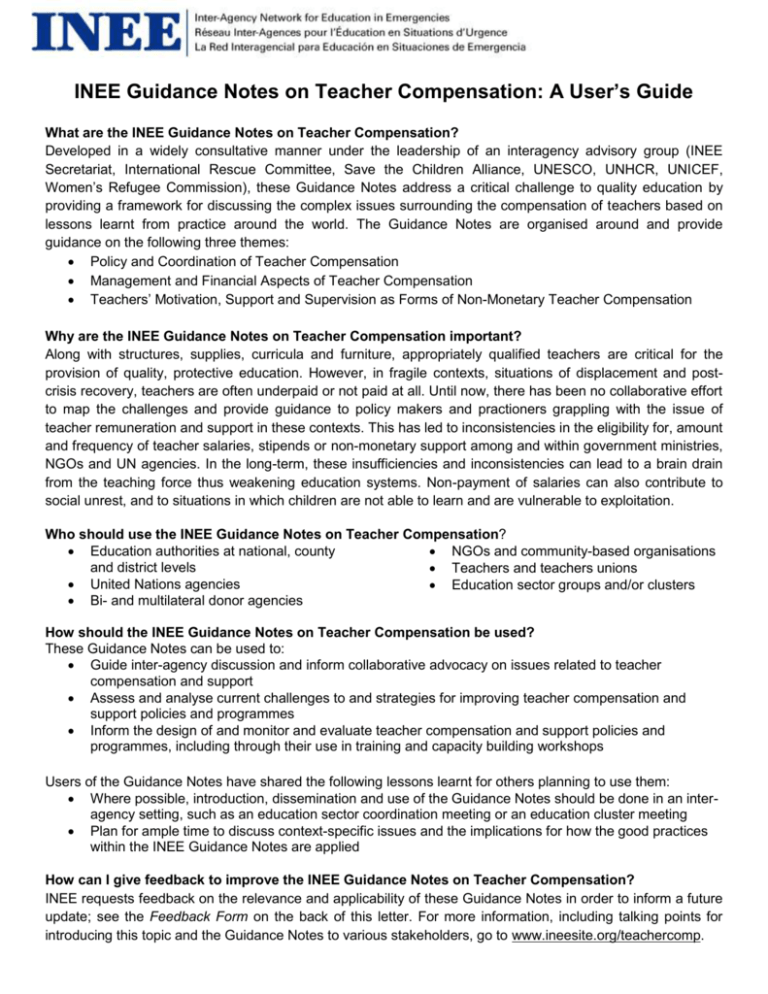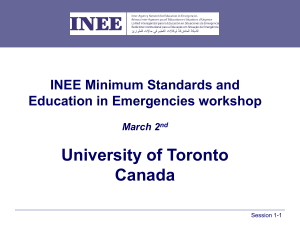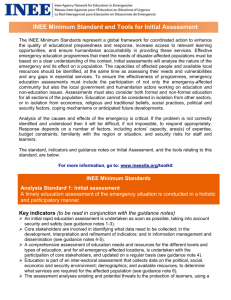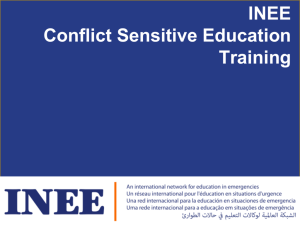Guidance Notes on Teacher Compensation: User`s
advertisement

INEE Guidance Notes on Teacher Compensation: A User’s Guide What are the INEE Guidance Notes on Teacher Compensation? Developed in a widely consultative manner under the leadership of an interagency advisory group (INEE Secretariat, International Rescue Committee, Save the Children Alliance, UNESCO, UNHCR, UNICEF, Women’s Refugee Commission), these Guidance Notes address a critical challenge to quality education by providing a framework for discussing the complex issues surrounding the compensation of teachers based on lessons learnt from practice around the world. The Guidance Notes are organised around and provide guidance on the following three themes: Policy and Coordination of Teacher Compensation Management and Financial Aspects of Teacher Compensation Teachers’ Motivation, Support and Supervision as Forms of Non-Monetary Teacher Compensation Why are the INEE Guidance Notes on Teacher Compensation important? Along with structures, supplies, curricula and furniture, appropriately qualified teachers are critical for the provision of quality, protective education. However, in fragile contexts, situations of displacement and postcrisis recovery, teachers are often underpaid or not paid at all. Until now, there has been no collaborative effort to map the challenges and provide guidance to policy makers and practioners grappling with the issue of teacher remuneration and support in these contexts. This has led to inconsistencies in the eligibility for, amount and frequency of teacher salaries, stipends or non-monetary support among and within government ministries, NGOs and UN agencies. In the long-term, these insufficiencies and inconsistencies can lead to a brain drain from the teaching force thus weakening education systems. Non-payment of salaries can also contribute to social unrest, and to situations in which children are not able to learn and are vulnerable to exploitation. Who should use the INEE Guidance Notes on Teacher Compensation? Education authorities at national, county NGOs and community-based organisations and district levels Teachers and teachers unions United Nations agencies Education sector groups and/or clusters Bi- and multilateral donor agencies How should the INEE Guidance Notes on Teacher Compensation be used? These Guidance Notes can be used to: Guide inter-agency discussion and inform collaborative advocacy on issues related to teacher compensation and support Assess and analyse current challenges to and strategies for improving teacher compensation and support policies and programmes Inform the design of and monitor and evaluate teacher compensation and support policies and programmes, including through their use in training and capacity building workshops Users of the Guidance Notes have shared the following lessons learnt for others planning to use them: Where possible, introduction, dissemination and use of the Guidance Notes should be done in an interagency setting, such as an education sector coordination meeting or an education cluster meeting Plan for ample time to discuss context-specific issues and the implications for how the good practices within the INEE Guidance Notes are applied How can I give feedback to improve the INEE Guidance Notes on Teacher Compensation? INEE requests feedback on the relevance and applicability of these Guidance Notes in order to inform a future update; see the Feedback Form on the back of this letter. For more information, including talking points for introducing this topic and the Guidance Notes to various stakeholders, go to www.ineesite.org/teachercomp. INEE Guidance Notes on Teacher Compensation in Fragile States, Situations of Displacement and Post-Crisis Recovery FEEDBACK FORM Thank you for sharing your experience using the INEE Guidance Notes on Teacher Compensation. This feedback will inform an update of and strategy for promotion of these Guidance Notes. Please fill in this questionnaire and return it to the INEE Secretariat at info@ineesite.org1. Date: Name: Organisation and job title: Address: Phone/fax: E-mail: 1. Please list the ways in which you or your organization have used the INEE Guidance Notes on Teacher Compensation. Be as specific as possible and include the ways (if any) in which you adapted the Guidance Notes to your context and to the work of your project/ organization/ coordination structure etc. 2. What challenges have you encountered while using the INEE Guidance Notes on Teacher Compensation and how did you overcome or work around them? 3. Can you share any lessons learned and/or examples of good practice from your experience using the INEE Guidance Notes on Teacher Compensation? What has been the impact of using the INEE Guidance Notes to address teacher compensation? 4. Based on your experience, what additional information and/or tools would make the INEE Guidance Notes on Teacher Compensation more relevant and easily applicable to addressing teacher compensation issues? 5. Please provide any additional comments or feedback on the INEE Guidance Notes on Teacher Compensation: 1 Additional information that you would like to share on the issue of teacher compensation, for example in the form of a longer case study, would be welcome and would be compiled and shared on the INEE website for wide readership. Contact: info@ineesite.org






